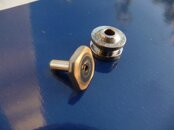spoolin01
Contributor
I posted a longer version over on DIY, but just crickets so far.
I've got a Mares MR22 that went into free flow with little warning. The seat looks like it fractured. The cone has some scarring across the seating edge that more or less seems to match up with the damaged spots on the seat. I don't know if those are both symptoms of some event, or if a damaged cone stressed the seat. The reg went >200 dives after being rebuilt by a LDS.
I read on the internet that the MR22 cone is the same as that in many of the Aqualung regs. I had just serviced two Titans in the days before opening up the MR22 and indeed they look the same to me. Except that the Titan cones had sharp edges and the one in the MR22 is rounded and seems polished at the crown. Is this normal wear? Original design? Sloppy triage?
I'll probably buy the Mares kit for converting to the trimaterial seat, but as a general matter I'm interested to know about these original parts.
Here's a pic of the cone and seat.
I've got a Mares MR22 that went into free flow with little warning. The seat looks like it fractured. The cone has some scarring across the seating edge that more or less seems to match up with the damaged spots on the seat. I don't know if those are both symptoms of some event, or if a damaged cone stressed the seat. The reg went >200 dives after being rebuilt by a LDS.
I read on the internet that the MR22 cone is the same as that in many of the Aqualung regs. I had just serviced two Titans in the days before opening up the MR22 and indeed they look the same to me. Except that the Titan cones had sharp edges and the one in the MR22 is rounded and seems polished at the crown. Is this normal wear? Original design? Sloppy triage?
I'll probably buy the Mares kit for converting to the trimaterial seat, but as a general matter I'm interested to know about these original parts.
Here's a pic of the cone and seat.




